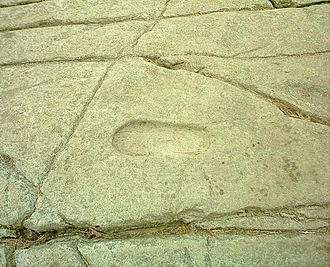Petrosomatoglyph





Petrosomatoglyph is a term used to describe rock art that represents parts of the human body, such as footprints, handprints, or other bodily impressions. These carvings or engravings are found on natural rock surfaces and are often associated with ancient cultural or religious practices.
Etymology[edit]
The word "petrosomatoglyph" is derived from the Greek words "petra" meaning "rock," "soma" meaning "body," and "glyph" meaning "carving" or "engraving." Thus, it literally translates to "rock body carving."
Types of Petrosomatoglyphs[edit]
Petrosomatoglyphs can be categorized based on the part of the body they represent:
- Footprints - These are the most common type and are often found in areas of religious or cultural significance. They are sometimes referred to as petrosomatoglyph footprints.
- Handprints - Less common than footprints, these carvings are also found in various cultural contexts.
- Other bodily impressions - These can include carvings of faces, torsos, or other body parts.
Cultural Significance[edit]
Petrosomatoglyphs are found in many cultures around the world and often hold significant cultural or religious meaning. For example:
- In Buddhism, footprints of the Buddha are considered sacred and are often found in temples and other holy sites.
- In Christianity, footprints of saints or other holy figures are sometimes venerated.
- In Indigenous Australian cultures, petrosomatoglyphs can be part of Dreamtime stories and are considered sacred.
Examples of Petrosomatoglyphs[edit]
- Adam's Footprint - Located in Sri Lanka, this is a large footprint believed to be that of Adam or the Buddha, depending on the religious context.
- Footprints of the Buddha - Found in various locations across Asia, these are often intricately carved and highly revered.
- St. Patrick's Footprint - Found in Ireland, this is believed to be the footprint of St. Patrick, the patron saint of Ireland.
Archaeological Studies[edit]
Archaeologists study petrosomatoglyphs to understand the cultural and religious practices of ancient peoples. These studies often involve detailed analysis of the carvings, their locations, and their historical contexts.
Preservation[edit]
Preserving petrosomatoglyphs is important for maintaining cultural heritage. Efforts include:
- Protecting sites from vandalism and natural erosion.
- Documenting and photographing the carvings for future study.
- Educating the public about the significance of these ancient artworks.
See Also[edit]
References[edit]
<references group="" responsive="1"></references>
External Links[edit]
Ad. Transform your life with W8MD's Budget GLP-1 injections from $75


W8MD offers a medical weight loss program to lose weight in Philadelphia. Our physician-supervised medical weight loss provides:
- Weight loss injections in NYC (generic and brand names):
- Zepbound / Mounjaro, Wegovy / Ozempic, Saxenda
- Most insurances accepted or discounted self-pay rates. We will obtain insurance prior authorizations if needed.
- Generic GLP1 weight loss injections from $75 for the starting dose.
- Also offer prescription weight loss medications including Phentermine, Qsymia, Diethylpropion, Contrave etc.
NYC weight loss doctor appointmentsNYC weight loss doctor appointments
Start your NYC weight loss journey today at our NYC medical weight loss and Philadelphia medical weight loss clinics.
- Call 718-946-5500 to lose weight in NYC or for medical weight loss in Philadelphia 215-676-2334.
- Tags:NYC medical weight loss, Philadelphia lose weight Zepbound NYC, Budget GLP1 weight loss injections, Wegovy Philadelphia, Wegovy NYC, Philadelphia medical weight loss, Brookly weight loss and Wegovy NYC
|
WikiMD's Wellness Encyclopedia |
| Let Food Be Thy Medicine Medicine Thy Food - Hippocrates |
Medical Disclaimer: WikiMD is not a substitute for professional medical advice. The information on WikiMD is provided as an information resource only, may be incorrect, outdated or misleading, and is not to be used or relied on for any diagnostic or treatment purposes. Please consult your health care provider before making any healthcare decisions or for guidance about a specific medical condition. WikiMD expressly disclaims responsibility, and shall have no liability, for any damages, loss, injury, or liability whatsoever suffered as a result of your reliance on the information contained in this site. By visiting this site you agree to the foregoing terms and conditions, which may from time to time be changed or supplemented by WikiMD. If you do not agree to the foregoing terms and conditions, you should not enter or use this site. See full disclaimer.
Credits:Most images are courtesy of Wikimedia commons, and templates, categories Wikipedia, licensed under CC BY SA or similar.
Translate this page: - East Asian
中文,
日本,
한국어,
South Asian
हिन्दी,
தமிழ்,
తెలుగు,
Urdu,
ಕನ್ನಡ,
Southeast Asian
Indonesian,
Vietnamese,
Thai,
မြန်မာဘာသာ,
বাংলা
European
español,
Deutsch,
français,
Greek,
português do Brasil,
polski,
română,
русский,
Nederlands,
norsk,
svenska,
suomi,
Italian
Middle Eastern & African
عربى,
Turkish,
Persian,
Hebrew,
Afrikaans,
isiZulu,
Kiswahili,
Other
Bulgarian,
Hungarian,
Czech,
Swedish,
മലയാളം,
मराठी,
ਪੰਜਾਬੀ,
ગુજરાતી,
Portuguese,
Ukrainian
